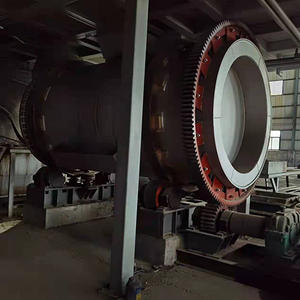Anode furnace (refining furnace), also called rotary refining furnace, is suitable for refining molten blister copper.

The refining operations are feeding, oxidation, reduction, and casting, and the product is anode plate. There is a furnace opening on the cylindrical furnace body for charging and copper discharge. There is a small amount of tuyere on the side of the furnace body. High-pressure air is introduced into the oxidation period, and reducing agent is introduced into the reduction period. When the tuyere is not in operation, it is placed in the furnace. Above decent, when performing redox operations, tilt the furnace so that the tuyere is buried in the melt.
Notes on the use of anode furnace:
First, the furnace temperature of the anode furnace is higher than 1350 °C. Unlike the fixed furnace, there is no fixed molten pool (slag) line. The erosion of the slag and the erosion of the molten metal almost involve more than 2/3 of the inner surface of the furnace;
Second, because the furnace needs to be rotated frequently, the masonry and the steel shell must be in close contact, and the static friction between the masonry and the steel shell must be increased to overcome the rotational torque to maintain the stability of the masonry, so there is no light insulation layer. ;
Third, in order to reduce the load of the masonry (to reduce the load of the support device and reduce the power consumption of the transmission), the thickness of the masonry layer should be reduced as much as possible under the conditions that the surface temperature of the steel shell allows (300 ° C).
In addition, in the two impact areas of feeding, considering the influence of temperature fluctuations during feeding, fused semi-rebonded magnesia-chrome bricks are also selected in this part. Due to the convenience of structure and construction, the combustion port and flue gas outlet are knotted with magnesia-chromium ramming material. If you have other questions about rotary refining furnaces, please contact Lufeng to answer your questions.
 English
English  Español
Español  Português
Português  русский
русский  français
français  日本語
日本語  Deutsch
Deutsch  Tiếng Việt
Tiếng Việt  Italiano
Italiano  Nederlands
Nederlands  ไทย
ไทย  Polski
Polski  한국어
한국어  Svenska
Svenska  Malay
Malay  বাংলা
বাংলা  हिन्दी
हिन्दी  Pilipino
Pilipino  Türk
Türk  عربى
عربى  Indonesia
Indonesia  norsk
norsk  čeština
čeština  Українська
Українська  Javanese
Javanese  فارسی
فارسی  తెలుగు
తెలుగు  Burmese
Burmese  български
български  Latine
Latine  Azərbaycan
Azərbaycan  Српски
Српски  Esperanto
Esperanto  Afrikaans
Afrikaans  Català
Català  Cymraeg
Cymraeg  Беларус
Беларус  Hrvatski
Hrvatski  Kreyòl ayisyen
Kreyòl ayisyen  Shqiptar
Shqiptar  Bosanski
Bosanski  Кыргыз тили
Кыргыз тили  ಕನ್ನಡ
ಕನ್ನಡ  IsiXhosa
IsiXhosa  Chichewa
Chichewa  Somali
Somali  O'zbek
O'zbek  հայերեն
հայերեն  Sundanese
Sundanese  Malagasy
Malagasy 






